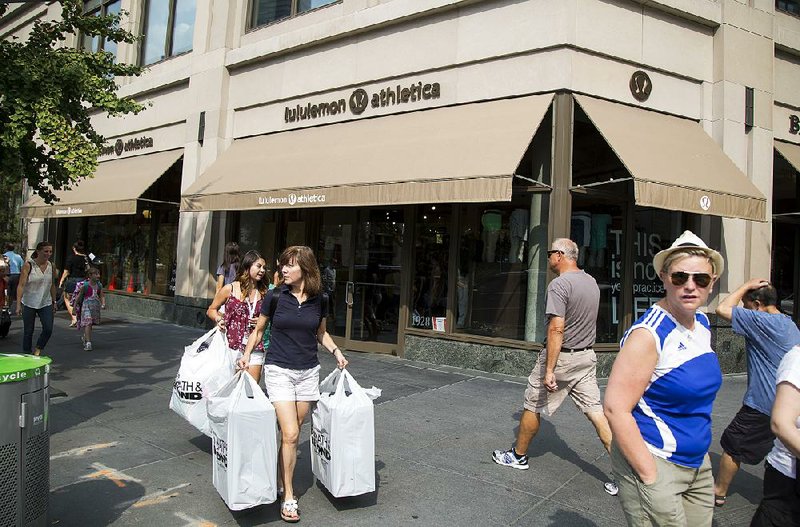WASHINGTON -- Americans stepped up their spending on cars, restaurant meals, groceries and clothing in August, suggesting that consumers will help sustain U.S. economic growth despite a broader global slowdown.
The Commerce Department said Tuesday that retail sales rose 0.2 percent last month, after advancing 0.7 percent in July. Sales have increased 2.2 percent over the past 12 months as solid hiring has translated into surges in spending at auto dealers and dining establishments.
"There was more spending on 'wants' last month" such as eating out, sporting goods and electronics, said Jennifer Lee, a senior economist at BMO Capital Markets. "These are areas that suggest consumers are ready and willing to splurge a little on items outside of the basic necessities."
Retail sales have been fed this year by solid and steady job gains. The hiring -- 2.9 million additional jobs over the past 12 months -- has translated into a surge of spending at auto dealers and restaurants. The U.S. economy has become increasingly reliant on consumer spending to maintain growth as Europe and China have struggled to expand at a faster pace.
Carmakers are on pace to top vehicle sales of 17 million for the first time since 2001. Nearly a fifth of all retail sales tracked by the government come from the auto industry. Sales at dealerships and parts stores have risen 5.7 percent during the past 12 months, as many Americans are replacing their older vehicles. Auto retailers reported a 0.7 percent increase in August.
The healing job market also has Americans getting out of their own dining rooms more frequently. Purchases at restaurants and bars increased 0.7 percent in August and have risen 8.2 percent this year. Dining establishments have added more than 372,000 workers over the past year to satiate the new business.
Sales also improved last month at grocers, clothiers, sporting goods stores, electronics outlets and online retailers.
Overall, retail sales growth has been much more modest, mostly because gasoline is significantly cheaper, causing purchases at service stations to drop 17.2 percent since August 2014.
Consumers have mostly pocketed the savings instead of shifting their spending elsewhere as gasoline costs averaged $2.33 a gallon nationwide -- a 31.5 percent drop over the past year, according to AAA.
In August, spending at gasoline stations slid 1.8 percent.
The retail sales report also indicated a possible pullback in the housing sector's momentum, as purchases at furniture stores and building supply stores fell in August after gains over the past 12 months.
Economists watch the retail sales report closely because it provides the first indication each month of the willingness of Americans to spend. Consumer spending drives 70 percent of the economy. Yet retail sales account for only about one-third of spending, with services such as haircuts and Internet access making up the other two-thirds.
Factory production declined in August by the most since January 2014, the Federal Reserve reported Tuesday, as automakers scaled back after a surge the month before and a stronger dollar weighed on demand from overseas customers.
The 0.5 percent decrease followed a revised 0.9 percent advance in the prior month. Excluding motor vehicles, factory production was unchanged. Total industrial output, which also includes mines and utilities, fell 0.4 percent after a 0.9 percent gain.
Tepid economies abroad, elevated inventories in the United States and an appreciating dollar signal limited order growth for domestic producers. The strength of manufacturing will depend on whether consumer spending remains resilient and corporate investment can build momentum.
"It's a combination of inventory adjustment domestically and weak growth abroad not aided by the strong dollar," said Josh Shapiro, chief U.S. economist at Maria Fiorini Ramirez in New York. "I would expect for the next few months, we're going to get soft numbers here and any improvement is going to be gradual."
Manufacturing in the New York region contracted in September for a second month, reflecting falling orders and employment. The Federal Reserve Bank of New York said Tuesday that its general economic index was little changed at minus 14.7, from minus 14.9 in August.
U.S. businesses added to their stockpiles by a tiny amount in July.
Business inventories increased 0.1 percent in July, compared with June when stockpiles were up 0.7 percent, the Commerce Department said Tuesday. The July gain was the smallest since a 0.1 percent increase in March. Sales were also up 0.1 percent in July after a 0.3 percent rise in June. Sales had fallen for seven straight months through February and have been posting modest increases since then.
Information for this article was contributed by Josh Boak and Martin Crutsinger of The Associated Press and Michelle Jamrisko of Bloomberg News.
Business on 09/16/2015
